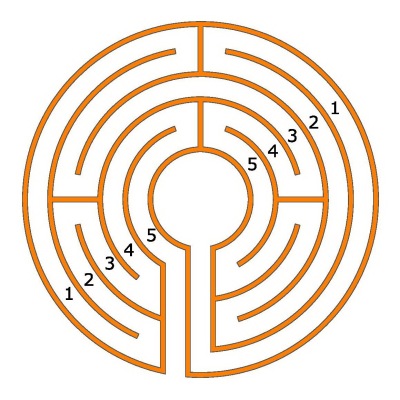The Chartres labyrinth has many qualities. It allows several variations, among others through the reduction of the number of circuits. So I can derive a 5-circuit labyrinth from the 11-circuit original. By leaving out the first 6 circuits (if I count from the outside inwards). See the following drawing:
By the way, I can also cut out the 6 inner circuits and take only the 5 outermost ones. This works also. See the following drawing:
Here the 5-circuit Chartres labyrinth as a whole. Sometimes it is called Inner Chartres, but as we have seen we could name it also Outer Chartres:
Let us look a little more exactly to the path sequence: At first one comes quite near to the middle, namely on circuit 5. Then I go outwards in turn: 4 – 3 – 2 – 1, even if that leads me to different sectors. In some Roman labyrinths this happens in every sector. Finally I reach the centre directly from the outermost circuit. This is a shortened reproduction of the path sequence of the 11-circuit original, however, contains their whole dramaturgy.
There are only a few concrete examples of this type up to now, as for example the one in Nieuwegein in the Netherlands which I could visit this year.
Can I now produce from this Chartres Labyrinth a classical labyrinth with the circuits not interrupted and the four typical turning points by leaving out the barriers in the vertical and horizontal axes? It is possible. Here the result:
The path sequence is identical with the one in the preceding Chartres labyrinth: 5 – 4 – 3 – 2 – 1 – centre. We have got a round classical labyrinth with a large middle and a central and common axis for the last piece of the path and the centre. But the four turning points do not lie in a square as we know it from the classical labyrinth with the small middle. To change this we determine the seed pattern and draw a labyrinth with a small middle. Here the result:
We see the habitual four points with the central cross. But in the middle we have a line more. The vertical axis is so to speak divided in two lines. So we get the same path sequence as in the Chartres labyrinth.
There are still other path sequences known for the 5-circuit classical labyrinth, as for example the one in Peter’s rockery labyrinth.
Can one now generate from the 5-circuit classical labyrinth with the small middle one with a bigger middle which can be called then Knidos labyrinth? It is possible. Here the drawing:







It is interesting that this 11-ring graph in actuality consists of two disjoint graphs in their own right, which are sequentially linked together. (As you have shown.) One could use this principle, obviously, to create an indefinitely large maze. (But it would become redundant to travel.) I wonder if there are ay ways to study the complexity of mazes. There must be, mathematically.
This one exists at Chartres? I will have to take my son there someday. 🙂
LikeLiked by 1 person
Pingback: How to make two Chartres Labyrinths from one Chartres Labyrinth | blogmymaze
Ek het ‘ erf langs ons huis gekoop en wil graag n Labyrint daarop aanbring vir almal om te kom loop. Die erf is in ‘n vakansiedorpie naby Naboomspruit. Daar is geen heinings tussen die huise nie en ek dink ‘n labyrint kan vir baie mense iets beteken. Ek het egter hulp nodig. Ek weet nie waar om te begin nie. Is daar iemand wat kan raad gee?
Groete
Mri Swanepoel
Sel: 0721486900
LikeLike
Pingback: Type or Style / 4 | blogmymaze
Pingback: The Pattern in Labyrinths with Multiple Arms | blogmymaze
Erwin, thank you for this teaching! You make it look easy, which is a sign of mastery. 🙂
LikeLiked by 1 person
Thank you, Jim, for your kind compliments.
LikeLike
Pingback: Considering meanders and labyrinths « blogmymaze
Thank you! We are working on the landscape design for our new home and plan to incorporate a labyrinth. The Chartes design is my favorite and I planned to design an abbreviated version. Now, thanks to you, the pattern is right here in front me!
LikeLike